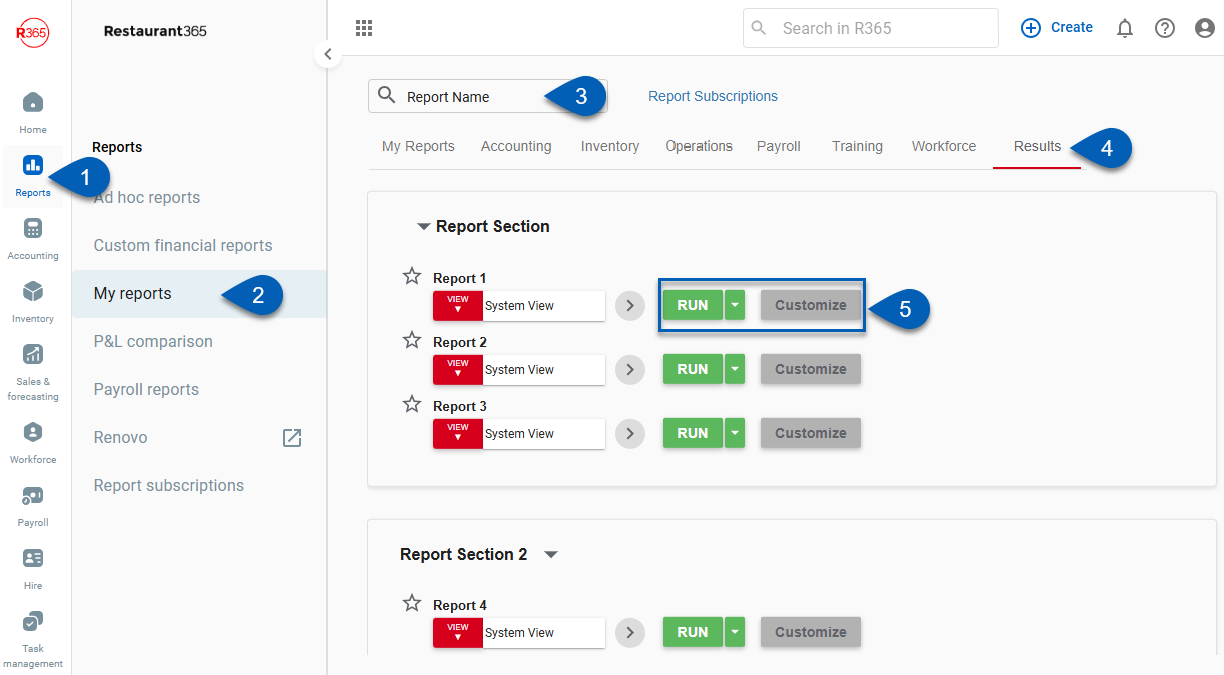The Labor Hour and Rate Analysis report is used to examine labor costs by analyzing worked hours and corresponding pay rates. The purpose of this report is to help restaurant managers and owners understand labor expenditures, monitor labor efficiency, and control labor costs. By breaking down labor data, the report assists in identifying trends, spotting potential overstaffing or understaffing issues, and ensuring that labor expenses align with budgetary goals. This detailed analysis supports better scheduling decisions by helping managers prevent overtime or other costly labor penalties.
.png)
Navigation
The My Reports search bar can be used to search R365's entire catalog of reports.
- Open the Reports app.
- Navigate to My Reports.
- Enter all or part of the report name in the search bar.
- The Results tab will open with the list of search results.
- From beneath the report name, click Run to run the report with the selected report view.
-OR-
Click Customize to adjust the report parameters and run the report.

Report Parameters

Field | Description |
|---|---|
Filter By | A list of all filter categories. Filter categories will vary based by report. |
Filter | A list of filter options determined by the 'Filter By' category selected. |
Start | First date to include in the report. The Start and Ends dates create a date range for which data is displayed in the generated report. |
End | Last date to include in the report. The Start and Ends dates create a date range for which data is displayed in the generated report. |
Group By | Determines whether data is grouped by Location or by Employee. |
Job | Determines which jobs are included in the report. |
Employee | Determines which employees are included in the report. |
Include Employees | If Yes is selected, employee names appear below their job titles. |
Break Page Per Location | If set to Yes, the report includes a page break after each location, allowing users to more easily separate data when printed or downloaded. |
Identify Minors | If set to Yes, the word 'Minor' appears next to all employees who are under a certain age. |
Primary Location | If set to Yes, employees are sorted by primary location. If the employee worked at more than one location, all rows for the employee appear listed below their primary location, and the Location column specifies the actual physical location where the employee worked the shift. If set to No, each row for the employee appears under the actual physical location where the employee worked the shift. |
View options | This section provides options to select, save, edit, or delete a report view. |
Run | Generates the report. Click the down arrow to the right of the Run button to export, email, or print the report. |
Report Columns
.png)
Column | Description |
|---|---|
Location / Employee | If Group By Location was selected prior to running the report, this column is labeled Location and displays the name of the location for which data is shown. |
Employee Payroll ID | Number used to identify the employee in the payroll system. |
Worked Location | Location where the employee worked the shift. This column appears only if the Primary Location parameter is set to Yes. |
Job | Job that was worked. |
Reg Hours | Number of hours worked at a regular rate. |
Reg Rate | Regular rate of pay. |
Reg $ | Amount owed to the employee for hours worked at the regular rate. |
OT Hrs | Number of hours worked at an overtime rate. |
OT Rate | Overtime rate of pay. |
OT $ | Amount owed to the employee for hours worked at the overtime rate. |
Total Hrs | Total number of hours worked. |
Total $ | Total amount owed to the employee. |
Email, Export, or Print the Report
This report can be emailed, exported, or printed in custom formatting directly from the reporting window. Learn more about how to send, export, or print this report.
